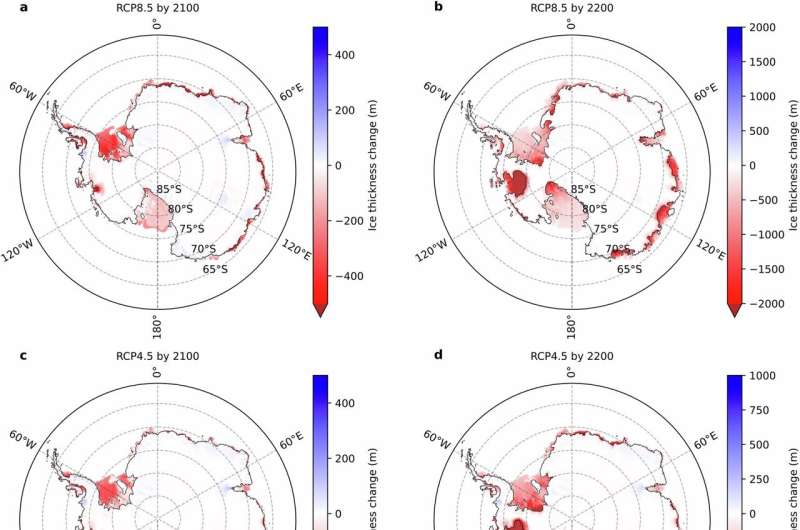Antarctic Meltwater Could Slow Warming While Pushing Sea Levels Higher in Some Regions

The latest research on Antarctic ice sheet melt is painting a complex picture of our future climate—one that’s not as straightforward as “warming equals melting equals rising seas.” A new study published in Nature Communications reveals that massive meltwater release from Antarctica may actually slow global warming in some parts of the world while still driving uneven and potentially extreme sea level rise across the planet. The scientists behind this study took a highly detailed look at what happens when the evolving Antarctic ice sheet is directly linked to the ocean and atmosphere in climate simulations. Their findings show that traditional climate models, which often ignore this dynamic interaction, may be missing crucial pieces of the puzzle.
The research team, led by Shaina Sadai with contributions from climate scientist Ambarish Karmalkar of the University of Rhode Island, wanted to improve how climate models represent the interplay between ice sheets and the global climate system. Using a simulated environment where the ice sheet, atmosphere, and ocean communicate with each other, the team uncovered several major outcomes that dramatically shift our expectations for the next century and beyond.
At the heart of the study is a counterintuitive result: as Antarctica melts, the cold fresh water entering the ocean appears to temporarily slow global warming. But this comes with a significant downside. That same meltwater leads to irregular global sea level rise, leaving certain regions—especially low-lying islands and coastal communities—at even greater risk.
Below is a detailed look at what the study found and why these results matter.
What the Study Examined
The researchers created a simulation that allowed Antarctica’s ice sheet to interact in real time with both the atmosphere and the ocean. This is a big step forward, because many older climate models don’t simulate ice sheets dynamically or don’t feed meltwater directly into the ocean in a realistic way. This lack of interaction has made it difficult to predict accurate global climate and sea level responses.
The team used a supercomputer to model how the Antarctic ice sheet might behave over the next couple of centuries under different greenhouse gas emission scenarios. They explored how meltwater influences everything from ocean circulation to atmospheric temperature patterns. Their experiment specifically looked at:
- The effect of meltwater on global temperatures
- How meltwater influences sea level rise in different regions
- The contribution of both East and West Antarctica to rising seas
- How changes in ice mass affect Earth’s gravitational pull and shape (a lesser-known but important factor in sea levels)
These simulations allowed them to track not only how fast the planet warms, but also how much sea levels rise across different parts of the world.
Key Findings on Climate Impacts
One of the most surprising results is that cold Antarctic meltwater actually slows warming in the Southern Hemisphere. This is because the influx of cold, fresh water stabilizes the upper layers of the ocean and promotes increased sea ice, both of which reflect sunlight and reduce heat absorption.
However, this cooling is far from universal. While the Southern Hemisphere cools, the Northern Hemisphere gets warmer, particularly regions around the North Atlantic and eastern North America. The researchers attribute this to disruptions in ocean circulation patterns, including changes to the distribution of heat between hemispheres.
What emerges is a world where climate trends start diverging sharply. The South cools slightly. The North warms noticeably. Precipitation patterns shift. Storm systems change behavior. And yet, even with this temporary cooling influence from meltwater, the long-term trajectory still shows continued warming—just redistributed differently.
Sea Level Rise: The Biggest Concern
Although the meltwater slows warming in some regions, it does not slow the rise of global sea levels. In fact, the opposite happens. Any amount of ice loss from Antarctica contributes to the ocean, raising sea levels globally. And the study finds that this rise is far from even.
Because Antarctica loses mass, its gravitational pull on nearby ocean water weakens. This causes water levels near Antarctica to fall slightly but pushes water outward, raising seas more dramatically in places farther away. This effect, combined with Earth’s deformational response to losing the weight of the ice sheet, creates a complex pattern sometimes called a sea level fingerprint.
The study found:
- In a very high emissions scenario, Antarctica may contribute over 3 meters (10 feet) of sea level rise by the year 2200.
- Even in a medium emissions scenario, Antarctica could add about 1 meter (3 feet) by 2200.
- The Pacific and Indian Oceans, along with the Caribbean, could see up to 1.5 meters (5 feet) of sea level rise in certain areas.
- Low-lying islands in the Pacific are among those facing the most significant increases.
Perhaps most notably, the East Antarctic Ice Sheet—which many previous studies considered relatively stable—begins contributing serious amounts of meltwater in high-emission futures. Since East Antarctica is enormous, any destabilization there is a major long-term threat.
Why This Matters for Coastal Communities
The timing couldn’t be more critical. By 2060, more than one billion people may be living in low elevation coastal zones, meaning even modest sea level rise puts huge populations at risk. The study highlights risks to:
- Island nations
- Coastal megacities
- Regions already facing erosion and flooding
- Geographically and socially vulnerable populations
With hurricane-driven storm surges becoming more destructive, higher sea levels amplify damage. The researchers note events such as the recent devastation caused by Hurricane Melissa in the Caribbean as an example of how rising seas make severe storms more dangerous.
The uneven distribution of rising seas also intensifies intergenerational and global injustice, as some regions—particularly those that contributed least to global emissions—will suffer the greatest impacts.
Why Realistic Ice-Sheet Modeling Matters
One major conclusion from the research is that many past climate projections underestimate both global and regional impacts because they don’t include realistic dynamic ice-sheet interactions. Meltwater entering the ocean isn’t just a side effect of warming—it actively alters ocean and atmospheric behavior.
As Ambarish Karmalkar points out, this kind of modeling is essential for understanding feedbacks between ice sheets and climate, which help determine future conditions across the entire globe.
The conclusion is clear: if we want accurate forecasts, we need models that show ice sheets interacting with the planet exactly as they do in reality.
The Importance of Reducing Emissions
The paper makes a strong point that current global commitments are not enough to meet the Paris Agreement goal of keeping global warming below critical thresholds. Without strong mitigation, we risk crossing tipping points that lead to irreversible ice sheet mass loss.
Reducing greenhouse gas emissions is the only way to limit how much Antarctica melts—and therefore the only way to control how much sea levels rise over the next centuries.
Additional Context: How Antarctic Meltwater Affects the Planet
To go a bit deeper, here are some extra points that help explain how meltwater reshapes climate and sea levels:
Ocean Circulation Disruption
Cold freshwater from Antarctica affects the formation of deep water in the Southern Ocean, a major driver of global heat distribution. Changes here ripple outward, influencing everything from monsoon systems to North Atlantic currents.
Gravitational Effects on Sea Level
The gravitational pull of large ice sheets actually draws in nearby seawater. When ice melts and mass is lost, the reduced gravity allows water to move away, raising sea levels more in distant regions.
The Long Memory of the Ice Sheet
Even if warming slows, sea level continues rising because ice sheet changes unfold over many centuries. This means decisions made today determine conditions for hundreds of years.
East Antarctic Ice Sheet Concerns
Although historically stable, parts of East Antarctica may be vulnerable if warming ocean water reaches its base. Because it holds enough ice to raise sea levels by tens of meters, its future behavior is critical to long-term projections.
Research Paper Link
Antarctic Meltwater Alters Future Projections of Climate and Sea Level – Nature Communications
https://www.nature.com/articles/s41467-025-64438-3





